I’ve always been drawn to wild places. It’s where the world makes the most sense. And when the beauty of wild trout—rising where they should, to a fly offered by one practiced in the art of grace and respect for such things—agrees with the surroundings, all is as it should be.
Judging by the raw setting atop West Virginia’s Black Mountain, on the eastern edge of the Cranberry Wilderness, I anticipated this to be a fitting theme for the four days to come. Fog tends to linger at 5,000 feet, and on that day, a damp spring chill, driven deeper by steady drizzle and wind, caused it to overstay it’s welcome. As my brother and I climbed into waders and shouldered packs outfitted for several days in the woods, our only clue as to the character of the projected few days was the hazy silhouettes of spruces and hemlocks, and a darkened trailhead in the treeline. Wild was an apt adjective.
A spring entered our slog through the muddied foot trail when we struck stream an hour into the descent. By all physical measurements, the tannic North Fork of the Cranberry River resembles a world-class brook trout stream—but physicality can be misleading.
Existing information on the upper reaches of the Cranberry system is polarized. One side of the fence reveres the North and South Forks as beautiful brook trout country, without citing specifics or making promises, while the other adamantly shouts “dead river.” For this reason, (and because I refuse to complete a writing assignment on any location that I haven’t personally experienced) I planned a five-day backpacking trip into the headwater region of the river to get the story for myself.
Rain turned to snow as overnight temperatures dipped into the low-30s, and morning came with the melodic crinkling of snowflakes against our tent’s rain fly. Camp was made on the middle reaches of the North Fork, to give us a good base to explore the lower and upper sections of river. After a quick breakfast of some creative arrangement of oats, my brother strung a fly rod.
My industry would be achieved with a camera and my hands. Taking a knee in the cold mountain water, I began methodically flipping over rocks, sifting through leafy debris, and perusing the surface of streamside boulders. Nothing in the form of pollution-intolerant macroinvertebrates presented itself.

Disappointed in my findings, I dried my hands and framed my brother with my viewfinder to work on another aspect of my job. As he nymphed a promising-looking pocket under a rhododendron bush, he seemed discouraged as well, having seen or felt no sign of life in several hours—factors that were undoubtedly leading him to the same hunch I was developing.
Nevermind, off to the lower river.
The clouds parted, revealing a much-welcome sun and blue sky. Our answer was found at the mouth of the creek, where a concrete and metal building branded with a sign reading “Neutralization Station” barged in on our wilderness experience. The pocket water of the North Fork below the facility ran lucid, unnaturally so, with a yellow-gray tint—presumably the result of dissolved calcium carbonate, limestone dust—and was subject to special regulations.
In the name of research, I spent hours methodically fishing and searching for macroinvertebrates in the quarter mile of stream below, and just above, the source of the limestone. Stick caddis, gray fox mayfly larvae, and stoneflies were found in relative abundance, but fish came in the form of a single, two-year-old brook trout, and two cookie-cutter, stocked rainbows. No fish persisted above the small dam at the treatment station.
Beautiful country, indeed, but as was becoming suspect, the underlying ecosystem had a past as dark as a foggy mountain hollow. During the heyday of West Virginia’s rampant coal mining industry in the early 1900s, countless stream miles were scorched of life due to acid mine drainage. Sulfides are concentrated in coal, and when exposed to water and air, become sulfuric acid, and seep from mines into adjacent watersheds, lowering pH levels, and rendering creeks uninhabitable by native brook trout.

Such was the case with the Cranberry River. Prior to the establishment of the regular liming treatment in the lower North Fork, its waters were so acidic that they prevented even the hardiest of warmwater species from existing. Today, the main stem, below the forks, is commonly revered as the Mountain State’s greatest trout fishery—though only as a stocked water.
On our hike back up into the headwaters to camp, I relaxed my mind, momentarily retreating into the hills from the disillusionment of the river’s reality. Native brook trout were rising where they should, on the seams of hemlock-lined plunge pools, to yellow sallies and sulfurs, before the cornucopian adulteration of a priceless ecosystem caught fire.
Few places remain truly wild—ungreased by the destructive hands of humanity—but many look and feel wild. Rivers epitomize these places. Fish tell us the difference, and give us a reason to take action.




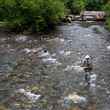
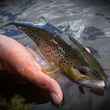





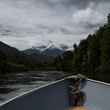
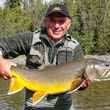



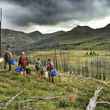
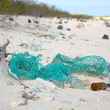








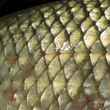
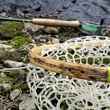

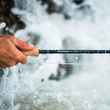

Comments
bill "parachute" adams replied on Permalink
Why did you hike in waders if you set up a base camp?
Matt Reilly replied on Permalink
Mike,
Good question. Trust me, I'll never hike that far in waders without a good reason! It was cold and rainy the afternoon we packed in, and the trail was washed out in many spots. Some places we sunk up to our calves in mud. So with those kinds of conditions, we figured on our bodies were as good a place to carry our waders as any. That, and after packing the essentials, 4 days of food, plus fishing and camera gear, there really wasn't a great place to pack them.
All the best.
Mike Trout replied on Permalink
What a shame. I lived in West Virginia for a few years and spent a lot of time blue-lining through the Mountain State. Its truly a beautiful and special place, and its a shame that much of its excellent-looking water is void of trout, particularly in the places that once held high populations. Nevertheless, West Virginia has many, many miles of water that hold healthy, thriving populations of wild rainbows, browns, and brookies. Good read.
Matt Reilly replied on Permalink
Mike,
I hear ya. Not much pains me more. Still, you're right on the wild fish. Just have to know where to look.
All the best.
wayne simon replied on Permalink
May 2020: I read your article concerning the Cranberry this winter while in the throes of COVID seclusion. I had read several glowing pieces about the river, and I was hoping your fishing experience was an outlier. I just returned from a 4 day backpacking/fishing trip to the Cranberry Wilderness/Backcountry. The weather was exceptional, no rain in the forecast. We hiked in from the Cranberry Campground parking lot and base camped near Pleasant Hollow shelter, 2 miles downstream from the confluence with the Dogway. The next morning we hiked up to the Dogway, noting the luxurious violets, columbine and other never before seen flowering plants beneath trees which were just beginning to leaf out. Large hemlocks and rhododendrons dotted the bank on both sides, and we stared intently into pools looking for motion from the high vantage points of the rip rap sections of the fire road. Disconcertingly, we saw no fish where they should have been holding. We split up at the low water bridge at he Dogway, two of us traveled up the catch and release section of the Cranberry while our third headed up the Dogway flyrod in hand. Four hours later we re-united; Dogway flyfisher reported no fish caught or seen, and my friend who I pool-hopped with up the Cranberry managed to catch a two rainbows on a Squirrel Tail Mepps. Though I fished each pool and hole diligently with Joes flies, Panther Martins and small Mepps, no fish for me, and also no fish seen. Normally at a minimum I’ll spook a few while wading up river. I am however, persistent if not talented. On the two mile hike back to camp I did manage to land a 4 inch Dace. Right before my friend hooked a 16 inch rainbow at a pool below the fire road a rip-rap. Lot of work for 4 (well really 3 and ½) fish.
Later that evening we had a conversation with an exceedingly generous outfitter who had established a fishing camp near the Pleasant Valley shelter, an activity permitted in the back country area. He had been in the business on the Cranberry for over 20 years, and thus has some knowledge of it’s condition and management. When queried about the coal mining in the area, he replied that clear cut logging prior to 1900 of the area, not mining, caused the acid runoff. I have read that acid runoff can also be caused by exposed iron pyrites, not only coal. He went on to say that the liming station on the Dogway and the Cranberry have been closed, and that the state has gone to seeding the banks of feeder creeks with limestone sands, and that the system was not working very well at consistently controlling the PH. He also said that the stocking levels were down significantly from the previous years due to COVID, and that the fish stocked into the roadside rip-rap pools were quickly fished out before they could disperse in the river. Basically that at this time few fish were in the river away from the roadside stocking locations. Added that after June there are no fish in the river at all due to water temperature rise, which I found hard to believe due to the protected watershed.
While exceptionally beautiful, the only fish that appeared to be available in this river in May of 2020 were a limited number of stocked fish; large pellet fed fish literally thrown by hand from the top of a tanker truck into pools near the rip rapped sections of the fire road.
The next day we again tried our luck; one decided to try downstream of camp, and the the pair of us headed far upstream on the catch and release portion of the Cranberry. Ran into another fisherman on his way back from this section; he was nymphing. Said he caught one 16 inch rainbow but not seen any fish moving about (which is not normal) and that he had covered a lot of territory. After fishing 2 miles of the river I had to agree with him. Saw no hatches of aquatic insects, in fact saw little life at all. Curious, I looked under a half dozen rocks and found very little larval insect life. Indicator of possible PH problems. It quickly became obvious to me that this was a dead river, much like Otter Creek in the Monongahela Nat. Forest which we had fished a few years before. If fish can't feed and reproduce in the river then what else is it? The Disneyland of fishing? Stock some trophy sized trout fed on pellets for 4 years and call it a premium trout fishing experience? Spoke to several fisherman on my trek the next day back down the stem to the campground parking area. Most seemed happy perched at the roadside pools catching the fish the stocking truck had provided the day before, and spoke of years past of fishes behind every rock. Others in full Cabela's regalia thrashed the pools near the campgrounds. Who am I to judge what creates happiness in others.
There is a dark past to the Monongahela forest; it is why it was created. Unbridled resource extraction. And I’m part of it: My relatives going back generations were coal miners and loggers in West Virginia. It provided a living for their families with some hope for the future. Guess this is my inheritance. Having some trouble with the hope for the future part.
Wayne Simon
Pages